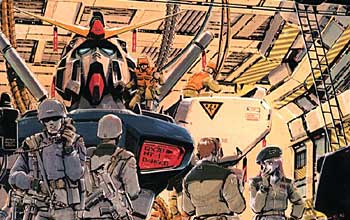by Paul Sudlow
|
Coming to America
"Gundam," from its earliest days, was a natural import to unleash on North America's then-ballooning market of cable stations. Why, then, did it take so long to cross the Pacific? It isn't like there weren't interested parties. During the "Robotech"/"Transformers" craze there were rumors of major players like Paramount sniffing around, and American anime importers weren't far behind. It never worked out, reportedly because Studio Sunrise consistently overvalued the franchise in America - at least in the minds of the interested corporations. It wasn't until 1990 that "Gundam" made its first official appearance in North America. Prompted no doubt by the success of its "Robotech" omnibus editions, Ballantine Books released in 1990 and 1991 a trilogy of "Gundam" novels penned by series creator Yoshiyuki Tomino (and translated by manga guru Frederik L. Schodt). Yet another incarnation of the One Year War (this one returning to the original "Mobile Suit Gundam" story), it left die-hard fans cold by giving short shrift to popular supporting characters, while failing to impress traditional science fiction readers. In short, it flopped. There the "Gundam" franchise might have sat forever - saddled with an overly expensive licensing fee and the legacy of a failed book line - if not for Bandai Japan. Bandai, which had made a mint on "Gundam" toys and model kits over the years, bought the golden goose outright in April of 1994 by acquiring Sunrise. Bandai soon put together a "Gundam" steering committee dedicated to the proper release of the saga in America and other Western markets. The ultimate result was Bandai Entertainment, which opened its doors in 1995 and entered the anime market in 1998. After experimenting with various "Gundam" releases aimed directly at hardcore anime fans - including subtitled editions of the original "Gundam" movies and more advanced fare such as "0080" and "0083" - Bandai Entertainment decided there wasn't any real future in appealing to the converted. It needed fresh blood to break out, and for that, it needed an appealing product and a mainstream venue.
The logical place to launch a new franchise is at the beginning, of course, but by the late '90s the animation techniques of 1978 and '79 were looking pretty long in the tooth, making "Mobile Suit Gundam" a potentially disastrous choice - lacking a previously established goodwill for the brand, would American viewers reject a "cheesy"-looking show without weighing the merits of character and story? But skipping ahead to later series in the saga posed problems as well, because they were written with the assumption viewers would be familiar with the back-story. Bandai Entertainment ultimately settled on the self-contained "Gundam Wing" saga as its launch vehicle. "Gundam Wing" debuted on the Cartoon Network on March 6, 2000, and the rest is history. Bandai, through its alliance with the Cartoon Network, hit it big. The show was a huge hit, and ran continuously for over a year in two versions - one sanitized version for the kids that aired during the day; and the original uncut version for adults that ran at midnight. |


